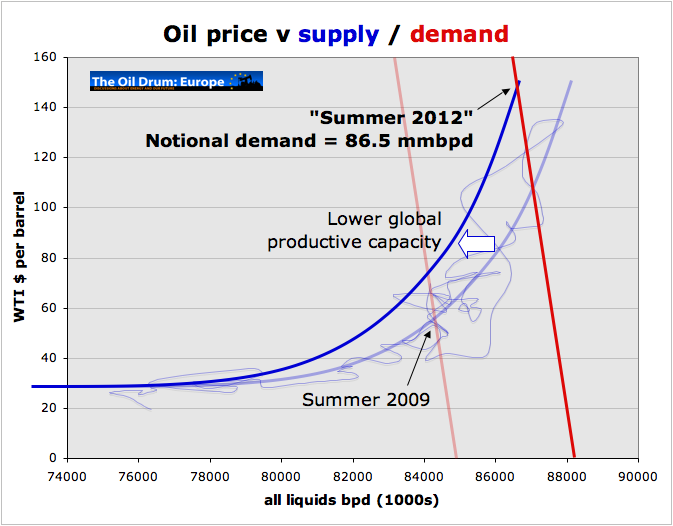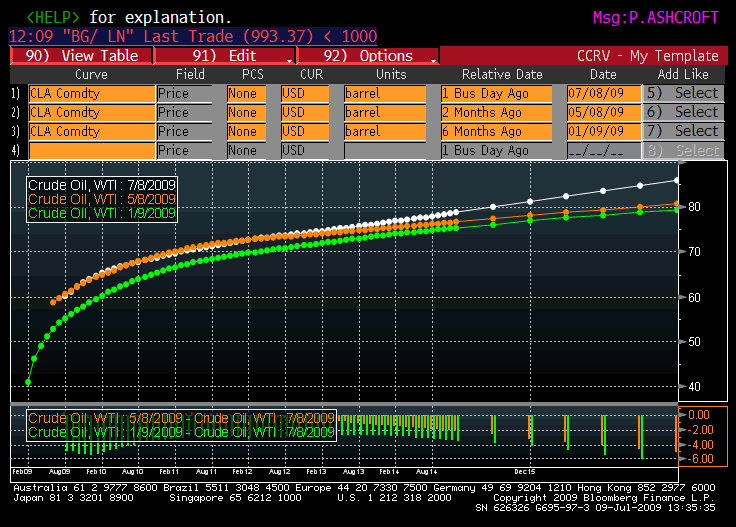Given that my view of non-OPEC supply goes radically against IEA and EIA estimates, here are a few highlights to track from recent reports (Simmons Institute and others):
Pemex June Production: Crude 2.52 million bbld (down 3.4% m/m from 2.61 mm bbld in May), Cantarell output was 604,498 bbld vs 641,350 bbld in May, down 5.7% m/m.
Norway: The Norwegian Petroleum Directorate (NPD) said that June liquids production was 2.083m b/d, -8.4%y/y. May was down 14% and 2Q overall down 6.8%. Gas production in June was up, 2Q was up 2% y/y.
Russia: Market expects Russia to deliver strong growth in 2009 and also in 2010. It is more likely to be flat at 10mboepd, and only because of natural gas liquids.
This means that even if we believe that Russia output will grow (and given capex cuts I find it difficult to believe, when Vankor is loss-making below $60/bbl even with the announced tax breaks), non-OPEC supply will not reach 50mbpd in 2009 versus IEA’s estimate of 50.8mbpd. 2010 non-OPEC supply may decline by 1 mmbd after peaking in 2007 (coinciding with the highest capex devoted to secondary and tertiary recovery ever senn in the industry).
2008 and 2009 were set to be key years for major project startups and production growth. However, it took a record level of startups and capex to keep non-OPEC supply just flat. Guidance for non-OPEC major project startups in 2010 and 2011 (combined) is 2 mmbd less than the 2008 + 2009 total.
Decline rates are estimated as high as 10% in non-OPEC and as from 2010 the decline in production is c3.5% pa.
Also, non-OPEC decline rates appear to have accelerated in recent years. Simmons calculate that 2008 decline rates were 1% to 2% faster than the proceeding 10-year average for 1998 to 2007.
Allow me to finish this diatribe with my favourite “underperforming versus hype” projects:
Vankor (Rosneft):Vankorskoye project (“Vankor”) was the big trumpeted start-up of 2008…. Now it’s “some time” in late 2009 (who wants to bet 2010?). The first stage of production has been quoted at 30 to 50 kbd, with Rosneft citing long-term peak production expectations of 400 kbd. Interesting to see the ramp-up curve on this one. We will likely see the figurtes quietly and surely brought down to a more realistic 250kbpd. Shell, whodiscovered it in 1988, believe it is uneconomical at $90/bbl ($60/bbl under new tax exemption if it happens) and deffinitely not as giant as Rosneft publicizes.
Atlantis (BP): First production was achieved at Atlantis in October 2007, with a near-term peak reached five months later in March 2008 at 102 kbd (almost half of BP’s trumpeted capacity for 200 kbd) despite 25 additional wells drilled by BP.
Azeri Chirag-Gunashli (BP): From 800kbpd target for 2009 to 700kbpd and falling, despite debottlenecking desperate efforts and “only” $4bn of added capex.
Thunder Horse (BP): According to a BP update in June 2009, seven production wells had been brought online thus far, with per-well production rates in excess of 40 kboed and overall production rates of approximately 300 kboed. However, liquids production target has been brought down to 150kbpd and ramp-up is now out of BP’s targets.
IEA have Russia up in 2009 vs 2008 (from 10mmbpd to 10.02) And FSU as well. They even increased estimates (IEA) in July. And they are still very close to 10mmbpd for Russia in 2010. OPEC overstates its own production (as they always do), particularly Saudi.
I find it impossible to reach IEA’s figures for those countries (US not in my list of worries). As per Halliburton’s figures the drilling is at 70% of planning capacity so it is virtually impossible to reach recovery rates. Especially in Siberia. In my view:
- Russia 9.8mmbpd (FSU 12.5mmbpd) versus IEA at 12.9fmmbpd
- Mexico 2.45mmbpd versus IEA (wait for this) 2.958!!!
- Norway 2mmbps (depends on corrosion) versus IEA’s 2.24mmbpd
- US 7.55mmbpd versus IEA’s 7.827mmbpd.
The three rules of oil investment are evident:
Don’t trust capacity estimates from ex-growth companies.
Don’t trust ramp-up figures from declining assets.
Don’t trust upgraded reserve estimates from new operators.

